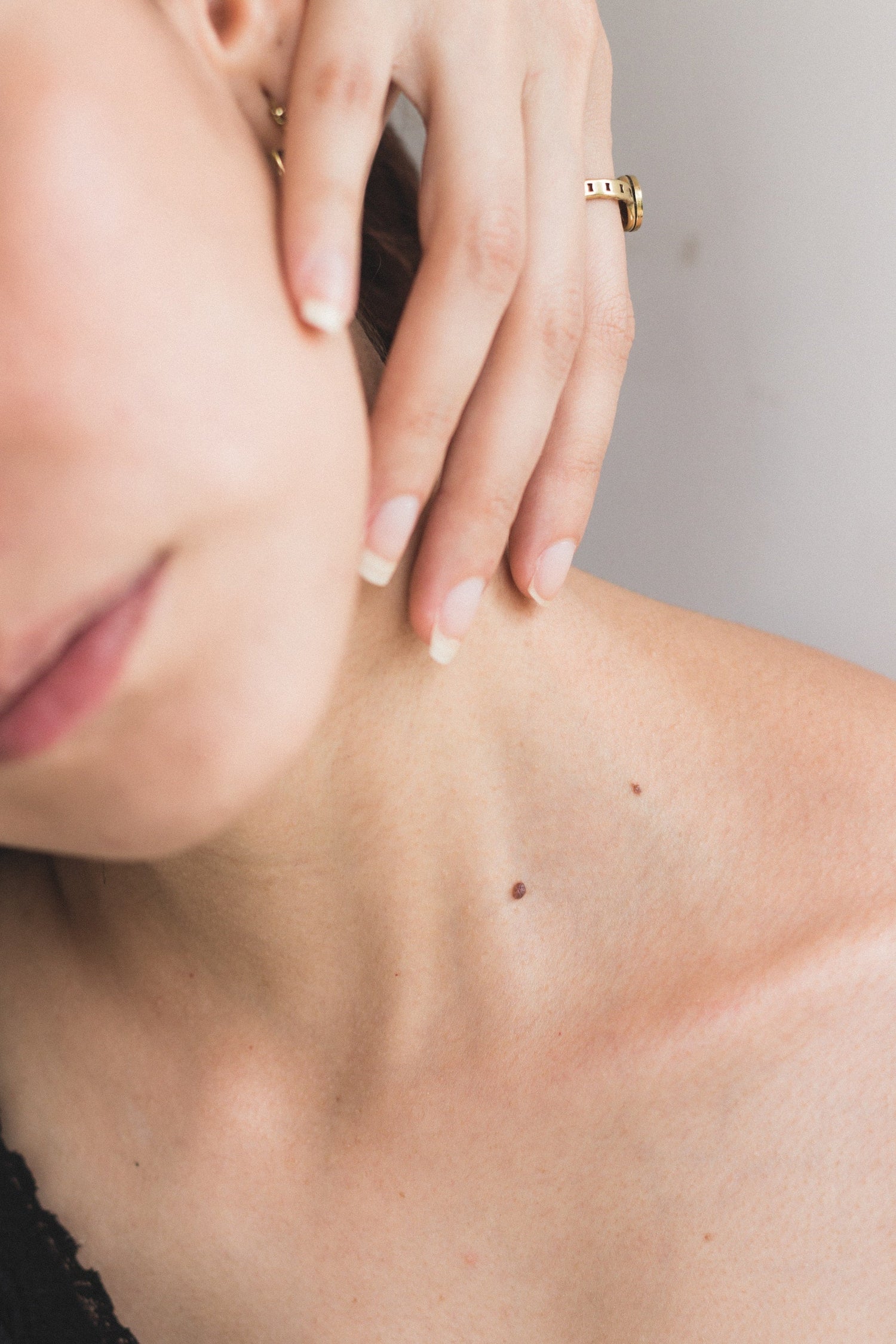When considering skin tightening treatments, it's important to weigh the benefits and drawbacks of both professional and at-home options. Professional RF treatments typically offer more impressive and consistent results, as well as the expertise and guidance of a trained practitioner.
If you purchase and use something designed for beginner, at-home use, you’ll save money in the short term and have greater control over when you do your treatments. However, they’re designed to be lower-power to account for untrained hands and, as a result, aren’t as effective per treatment as a professional device would be.
When you’re considering incorporating radiofrequency treatments into your regimen, whether for a major transformation or more minor maintenance, it’s important to consider which will be best for you.
Continue reading to learn more about the factors you must consider when weighing up the benefits and drawbacks of each type of treatment.

What Is Skin-Tightening?
As we age, our skin can begin to lose its elasticity. The cause of this is the gradual decline of two essential proteins, elastin and collagen, in the skin’s tissue. These important components for skin health are also replaced more slowly over time, resulting in common signs of ageing like fine lines, sagging and wrinkles. This is where skin-tightening treatments enter the picture.
Once upon a time, the only option for reversing this process was invasive surgery, like a traditional facelift. Patients were often left less than satisfied and faced a long recovery period. From intensive recovery periods to high costs and results that can be unpredictable or look less natural than patients want, oftentimes, starting off with something minimally invasive first is a better option. There’s been a recent rise in the popularity of at-home treatments, from red light therapy masks to radiofrequency heating devices for at-home use to boost collagen production.
The days of having only surgical or lower-powered at-home options are over, thanks to InMode and our range of innovative RF skin tightening treatments. This type of treatment is non-invasive and utilises various technologies, including RF energy and microneedling, to stimulate collagen production, which in turn helps to firm and tighten the skin for that highly-coveted, natural-looking result.
Whether you are looking to tighten and lift your neck, reduce the appearance of fine lines, or achieve an overall more youthful appearance, InMode’s suite of technology is here to help.
How Do Skin Tightening Treatments Work?
There are a variety of different skin tightening treatments out there, each with its own technology and approach. At-home treatments will often utilise a similar means of delivering radiofrequency to the skin’s tissue, though they operate at a significantly lower power level.
Radiofrequency can be applied topically, through the skin’s epidermis with therapeutic heating, or it can be delivered subdermally with the use of microneedling or a cannula. Both application methods work by heating the skin and prompting new collagen to be produced, delivering tighter, firmer-looking skin over successive treatments.
Let’s use the popular Morpheus8 as an example. Morpheus8 targets and strengthens the Fibro-Septal Network (FSN) and comes equipped with four fractional tips with different microneedle configurations for customised treatments. Depending on your skin concerns and aesthetic goals, the microneedles can operate at a superficial level in the epidermis, or reach deeper for collagen remodelling that simultaneously prompts the skin to produce more collagen and elastin.
By providing triple action in the form of ablation, fat coagulation, and volumetric heating, Morpheus8 can be used to reduce fine lines and wrinkles, pore size and improve the scarring that results from acne. Patients will benefit from tighter skin and reduced fat without the need for surgery and with minimal downtime.
The Rise of At-Home Skin Tightening Treatments
Devices like the Morpheus8, Forma and Plus have made skin-tightening treatments more affordable and accessible than ever. Conversely, patients are now investigating the possibility of conducting these treatments at home.
While there are devices on the market that allow you to perform these treatments at home, are they worth pursuing?
There’s no doubt that at-home skin tightening treatments are more accessible — after all, you don’t need to leave the comfort of your own house. But what you gain in convenience, you ultimately sacrifice in safety and results.
Let’s take a closer look at how professional vs at-home treatments sit side by side.
Comparison: Professional vs. At-Home Treatments
Wondering if you should book an appointment with a provider for clinical RF skin tightening or invest in a device you can use at home? Here are some of the pros and cons you will need to consider.
Safety
As with any treatment, whether it’s a topical product like a chemical exfoliant or something more intensive like radiofrequency, safety should always be the first consideration. Your skin will react differently to different products and procedures, and some may be more suitable for you than others. RF skin tightening is a procedure that should only be performed by a professional who understands the abilities and constraints of a device. Checking the condition of your skin, analysing the best way to treat it, both with the treatment volume and frequency, but also the intensity required, are key evaluations that only a qualified professional can provide.
A medical professional will start by asking a series of questions to confirm that RF skin tightening is an appropriate procedure for you. They will also explain any potential risks, common side effects and when to seek medical assistance.
Performing RF skin tightening at home does not come with the same professional support and safety measures.
Cost
The cost of a clinical RF skin tightening regime will depend on a number of factors, including the size of the area being treated, the severity of your skin issues and any additional costs on the part of the clinic. You may need anywhere between three to eight treatments, depending on the device you opt for and the severity of the condition you’re seeking to improve. If you’re treating a larger area, for example, the arms or legs, rather than a small and delicate area like the neck, the treatment plan will be significantly different.
Knowing that you’ll likely need a number of treatments to achieve your desired results, it’s a good idea to factor this in when calculating the long-term cost.
Purchasing an RF skin-tightening machine to use at home is a one-off investment. However, the device is likely to be costly and may not be as effective as a clinical-grade machine.
Duration of Procedure & Downtime
Regardless of whether you are performing RF skin tightening at home or in a professional setting, the duration of the procedure and the expected downtime will depend on the intensity of the procedure and the area you are treating. Higher power and more targeted treatments, like those with Morpheus8 and microneedling capabilities, will take significantly shorter treatment sessions. They also have greater capabilities than at-home applicators would, though if they’re using microneedles, they will have a slightly longer recovery time.
At-home RF treatments can be variable in terms of how much power you can apply, and, unless you’re highly skilled in aesthetic treatments, knowing how frequently to apply them means you may over- or under-treat. By contrast, when you visit a clinic with a trained aesthetician, you’ll get access to professional advice and a skilled approach to treating your unique anatomy. Your clinician will be able to give tailored advice about how long recovery will take and what precautions you need to take to ensure maximal treatment effectiveness.
Results
While we can’t speak to every at-home RF skin-tightening machine, it’s unlikely that any have the same level of innovative technology as the Morpheus8, Forma, or Plus.
InMode is an industry leader in innovative radio frequency, light-based energy and laser technologies. Our devices and workstations offer minimally invasive procedures that involve little to no downtime, and the fantastic results speak for themselves.
Maintenance after Procedure
Depending on the type of RF skin tightening treatment you receive, your skin may or may not require maintenance following the procedure. The only way to know for sure is by having the treatment performed by a professional.
If you purchase a home device, it may come with instructions on maintenance procedures you should follow after the treatment. However, these won’t be tailored to you and your medical history, meaning you risk doing harm or undoing all the work of the treatment.
For professional RF skin tightening treatments, speak to InMode. It’s clear that professional RF skin tightening treatments boast many advantages over at-home procedures. If you’re a clinic looking to increase your services to include RF skin tightening, contact the InMode team today to discuss our range of devices and workstations.






Leave a comment
All comments are moderated before being published.
This site is protected by hCaptcha and the hCaptcha Privacy Policy and Terms of Service apply.